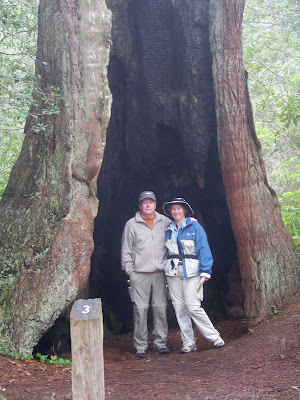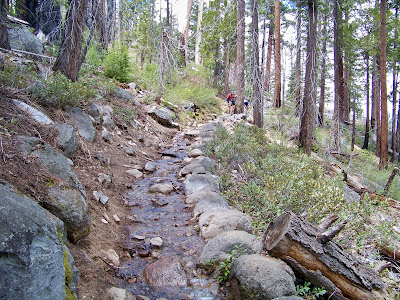Most visitors know Redwood National and State Parks as the home to the world's tallest trees. After our visit, I would agree with that statement. You will certainly get a kink in your neck from looking up to their massive heights.
The" Big Tree" stands at a height of 304 feet, has a diameter of 21.6 feet, and has a circumference of 68 feet. The tree is an estimated 1500 years old.
This is the top of the Big Tree. My camera cannot take an entire shot of these trees. They are too massive in heights to get a complete picture. The middle section of the tree has no branches. The bark on these trees is about 12 inches thick. Many of the trees are 1000-1500 years old.
You can see in this photo that the roots of the upright tree has grown around three fallen trees and has anchored itself into the ground to support its base. It will stay this way for many years. You constantly see this throughout the parks. I was amazed by the shallow roots of these huge trees. Instead of growing deep, the roots grow horizontally and entangle with roots of other trees.
Elk Meadows is a great place to see the Elks resting during the midday hours. We counted 4-5 calves, many were sleeping so I'm sure there were others resting as well.
As you hike along the Lady Bird Johnson Grove Trail, there is a plaque on the trail where former President Richard M. Nixon dedicated this grove to Lady Bird Johnson on 27 August 1969 in recognition of her efforts to help preserve the redwoods and other natural wonders. If you only get to visit one area during your tour, I would highly recommend this grove.
We had another visitor take a picture of Kathy and me in this hollowed out Redwood. This hollowed out redwood is a fire survivor. The fire that helps clear out the underbrush frequently also kills the other trees; but not the redwood. The thick bark of a redwood does not contain volatile resins like pines, and firs and its sap is mostly water. This makes the redwood more resistant to fire, however, fire can get through cracks in the bark and damage the more tender inner part of the tree. The hollowed out trees like this one provide important shelter for wildlife.
The wet moist shady woodland is a perfect growing condition for Ferns that were are abundant throughout the park.
You wander through a mature forest, seeing some examples of the huge redwoods, and plenty of other plants such as ferns. It was pretty misty the day we were there, which I thought gave the place some additional character.
Kathy decided to test her strength by pushing two Redwoods apart. I don't think this camera has the magic to make that happen. We had a great time visiting the Redwood Parks but I can honestly say that after visiting Sequoia National Park it was a little anti-climatic.


























































